AMP-Activated Protein Kinase (AMPK) Regulates Energy Metabolism through Modulating Thermogenesis in Adipose Tissue
- PMID: 29515462
- PMCID: PMC5826329
- DOI: 10.3389/fphys.2018.00122
AMP-Activated Protein Kinase (AMPK) Regulates Energy Metabolism through Modulating Thermogenesis in Adipose Tissue
Abstract
Obesity occurs when excess energy accumulates in white adipose tissue (WAT), whereas brown adipose tissue (BAT), which is specialized in dissipating energy through thermogenesis, potently counteracts obesity. White adipocytes can be converted to thermogenic "brown-like" cells (beige cells; WAT browning) under various stimuli, such as cold exposure. AMP-activated protein kinase (AMPK) is a crucial energy sensor that regulates energy metabolism in multiple tissues. However, the role of AMPK in adipose tissue function, especially in the WAT browning process, is not fully understood. To illuminate the effect of adipocyte AMPK on energy metabolism, we generated Adiponectin-Cre-driven adipose tissue-specific AMPK α1/α2 KO mice (AKO). These AKO mice were cold intolerant and their inguinal WAT displayed impaired mitochondrial integrity and biogenesis, and reduced expression of thermogenic markers upon cold exposure. High-fat-diet (HFD)-fed AKO mice exhibited increased adiposity and exacerbated hepatic steatosis and fibrosis and impaired glucose tolerance and insulin sensitivity. Meanwhile, energy expenditure and oxygen consumption were markedly decreased in the AKO mice both in basal conditions and after stimulation with a β3-adrenergic receptor agonist, CL 316,243. In contrast, we found that in HFD-fed obese mouse model, chronic AMPK activation by A-769662 protected against obesity and related metabolic dysfunction. A-769662 alleviated HFD-induced glucose intolerance and reduced body weight gain and WAT expansion. Notably, A-769662 increased energy expenditure and cold tolerance in HFD-fed mice. A-769662 treatment also induced the browning process in the inguinal fat depot of HFD-fed mice. Likewise, A-769662 enhanced thermogenesis in differentiated inguinal stromal vascular fraction (SVF) cells via AMPK signaling pathway. In summary, a lack of adipocyte AMPKα induced thermogenic impairment and obesity in response to cold and nutrient-overload, respectively, whereas chronic AMPK activation by A-769662 promoted WAT browning in inguinal WAT and protected against HFD-induced obesity and related metabolic dysfunction. These findings reveal a vital role for adipocyte AMPK in regulating the browning process in inguinal WAT and in maintaining energy homeostasis, which suggests that the targeted activation of adipocyte AMPK may be a promising strategy for anti-obesity therapy.
Keywords: A-769662; AMP-activated protein kinase; PGC-1α; energy metabolism; thermogenesis; white adipose browning.
Figures

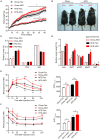

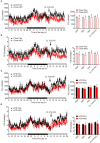
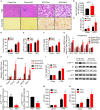
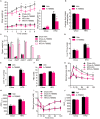
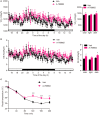
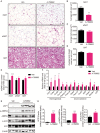
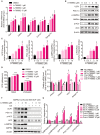
Similar articles
-
Pyrazolone derivative C29 protects against HFD-induced obesity in mice via activation of AMPK in adipose tissue.Acta Pharmacol Sin. 2021 Jun;42(6):964-974. doi: 10.1038/s41401-020-00524-0. Epub 2020 Sep 15. Acta Pharmacol Sin. 2021. PMID: 32934347 Free PMC article.
-
Loss of ADAMTS5 enhances brown adipose tissue mass and promotes browning of white adipose tissue via CREB signaling.Mol Metab. 2017 May 10;6(7):715-724. doi: 10.1016/j.molmet.2017.05.004. eCollection 2017 Jul. Mol Metab. 2017. PMID: 28702327 Free PMC article.
-
Overexpression of Adiponectin Receptor 1 Inhibits Brown and Beige Adipose Tissue Activity in Mice.Int J Mol Sci. 2021 Jan 18;22(2):906. doi: 10.3390/ijms22020906. Int J Mol Sci. 2021. PMID: 33477525 Free PMC article.
-
Emerging Role of AMPK in Brown and Beige Adipose Tissue (BAT): Implications for Obesity, Insulin Resistance, and Type 2 Diabetes.Curr Diab Rep. 2018 Aug 17;18(10):80. doi: 10.1007/s11892-018-1049-6. Curr Diab Rep. 2018. PMID: 30120579 Review.
-
Many Ways to Rome: Exercise, Cold Exposure and Diet-Do They All Affect BAT Activation and WAT Browning in the Same Manner?Int J Mol Sci. 2022 Apr 26;23(9):4759. doi: 10.3390/ijms23094759. Int J Mol Sci. 2022. PMID: 35563150 Free PMC article. Review.
Cited by
-
Polyphenol Compound 18a Modulates UCP1-Dependent Thermogenesis to Counteract Obesity.Biomolecules. 2024 May 23;14(6):618. doi: 10.3390/biom14060618. Biomolecules. 2024. PMID: 38927022 Free PMC article.
-
Clinically confirmed DEL-1 as a myokine attenuates lipid-induced inflammation and insulin resistance in 3T3-L1 adipocytes via AMPK/HO-1- pathway.Adipocyte. 2020 Dec;9(1):576-586. doi: 10.1080/21623945.2020.1823140. Adipocyte. 2020. PMID: 32954935 Free PMC article.
-
Ocimum basilicum L. Methanol Extract Enhances Mitochondrial Efficiency and Decreases Adipokine Levels in Maturing Adipocytes Which Regulate Macrophage Systemic Inflammation.Molecules. 2022 Feb 18;27(4):1388. doi: 10.3390/molecules27041388. Molecules. 2022. PMID: 35209178 Free PMC article.
-
Gintonin-enriched fraction protects against sarcopenic obesity by promoting energy expenditure and attenuating skeletal muscle atrophy in high-fat diet-fed mice.J Ginseng Res. 2022 May;46(3):454-463. doi: 10.1016/j.jgr.2021.10.003. Epub 2021 Oct 13. J Ginseng Res. 2022. PMID: 35600770 Free PMC article.
-
Four-and-a-Half LIM-Domain Protein 2 (FHL2) Induces Neuropeptide Y (NPY) in Macrophages in Visceral Adipose Tissue and Promotes Diet-Induced Obesity.Int J Mol Sci. 2023 Oct 6;24(19):14943. doi: 10.3390/ijms241914943. Int J Mol Sci. 2023. PMID: 37834391 Free PMC article.
References
-
- Abdul-Rahman O., Kristóf E., Doan-Xuan Q. M., Vida A., Nagy L., Horváth A., et al. . (2016). AMP-activated kinase (AMPK) activation by AICAR in human white adipocytes derived from pericardial white adipose tissue stem cells induces a partial beige-like phenotype. PLoS ONE 11:e0157644. 10.1371/journal.pone.0157644 - DOI - PMC - PubMed
LinkOut - more resources
Full Text Sources
Other Literature Sources
Molecular Biology Databases
Research Materials

